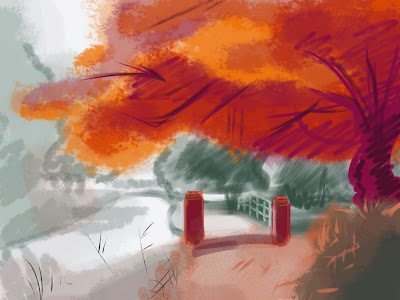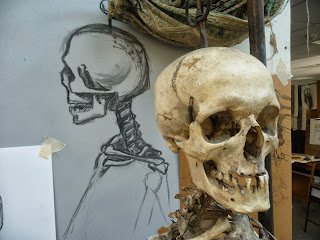At the start of our just-finished project, we were given a child's drawing of a character each and a sound clip of their choice to animate their character to, the idea being that once all of the characters have gone through the clean-up process and have been animated, we can take them back to the children and they can see their characters come to life! We're all very excited about it.
The sound clips were taken from the '
11 Second Club'. As I can't seem to upload my sound clip on blogger, if you would like to hear it, go to the
October 2009 competition on the website. The voice says, "TV is power. The power to lull, to pacify. And then when all eyes are glazed and all minds are jelly, the power to hold the world in your fist" in a deep man's voice. Imagine my chagrin then when my child drew a young girl character to animate to that clip!
Well, I am never one to back down from a challenge. First came initial responses and development of the character. Jessica was very specific with what she wanted, so there's only so much I can do before it's not her character any more!
When doing these designs, my first priority is making it a reasonable character to animate; keeping the detail down and staying with basic shapes, decreasing the pencil mileage.
Having drawn the character in 'my style' already, next I researched other styles. First I turned to other square-headed characters in popular culture and TV and then showing Jessica's drawing to my ever brilliant coursemates to see what they made of it.
Having finalised the design, next come construction sheets and turnarounds.
Down to the problem of putting a deep male voice with a little girl character! I explored a couple of staging ideas while I was still in the concept/design phase of the pre-production. Listening to what the voice is saying, it made sense in context for there to be a TV in the shot, and I thought that maybe the voice could be coming from the TV and the girl could be reacting to it.
Back to the character, how will she looks when she's cleaned up? Colour and texture model sheets.
I stayed true to the original drawing when it came to colour, using an eyedropper tool and then slightly tweaking the colours to fit more harmoniously together. Onto action and expression sheets.
Finally, I decided to stage the character inside the TV. The TV will have a mouth and eyes and the girl will be inside the TV trying to figure out where the voice is coming from before being 'lulled' and 'pacified'.
Having 'broken down' the sound (worked out on which frame each sound comes) I then had to work out what the mouth looks like for each sound, so below is a chart.
I hope you've enjoyed seeing my pre-production process!






































